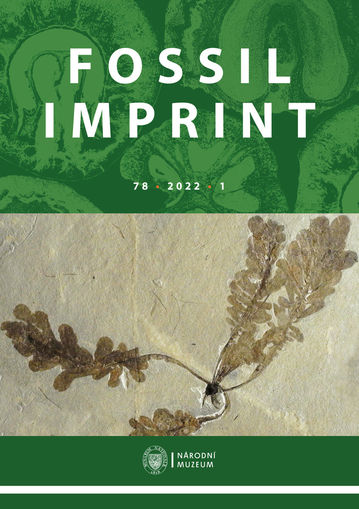
2022/78/1
ISSN : 2533-4050 (tisk), 2533-4069 (online)
Editor in Chief : Jiří Kvaček
Editor in Chief : Jiří Kvaček
Assessment of Phytogeographic Reference Regions for Cenozoic vegetation: a case study on the Miocene flora of Wiesa (Germany)
Lutz Kunzmann, Shu-Feng Li, Jian Huang, Torsten Utescher, Tao Su, Zhe-Kun Zhou
During the Miocene Climatic Optimum, a global long-term warm interval, European mid-latitude regions experienced a subtropical palaeoclimate. In particular, areas in eastern Germany were part of a vegetational zone with evergreen broadleaved forests, characterized by subtropical taxa. Regional…
The type of Palmocarpon cretaceum Miq., 1853 described from the Cretaceous of the Sint-Pietersberg, The Netherlands, is an Eocene Nypa burtinii (Brongn.) Ettingsh., 1879, most likely from the Brussels area, Belgium
Raymond W. J. M. Van der Ham, Johanna H. A. Van Konijnenburg-van Cittert, Sjir Renkens, Peta A. Hayes
The study of a few putative palm macrofossils from the type area of the Maastrichtian Stage appeared to have important implications for understanding the composition of the fossil flora of the area, as well as for the nomenclature of fossil palm fruits in general. The type specimen of the palm fruit…
The early middle Eocene Wagon Bed carpoflora of central Wyoming, U.S.A.
Bruce H. Tiffney, Steven R. Manchester
The early middle Eocene Wagon Bed fruit and seed flora of central Wyoming encompasses nine morphotypes that are assignable to extant genera (Alangium, Aphanathe, Canarium, Carya, Celtis, Iodes, Mastixia, Nyssa, Pleiogynium), four that are assignable to extinct genera in extant families (Chandlera,…
Flora, vegetation and climate assessment of the Early/Middle Miocene Parschlug flora indicates a distinctly seasonal climate
Johanna Kovar-Eder, Zlatko Kvaček, Vasilis Teodoridis, Petr Mazouch, Margaret E. Collinson
The late Early/early Middle Miocene flora from Parschlug (Styria, Austria) is famous for its numerous specimens and high diversity. Some taxa previously described are revised here and 42 new angiosperm leaf morphotypes/taxa are described. The Climate Leaf Analysis Multivariate Program (CLAMP) is…
A whole-plant specimen of the marine macroalga Pterigophycos from the Eocene of Bolca (Veneto, N-Italy)
Evelyn Kustatscher, Helmut Martin, Guido Roghi, Michael Krings
Uncalcified macroalgae are generally rare as fossils, and hence their past diversity and evolutionary history remain poorly resolved. The Bolca area in northern Italy has yielded abundant adpression fossils of Eocene macroalgae. However, the vast majority of specimens are detached blades and blade…
Remains of a subtropical humid forest in a Messinian evaporite-bearing succession at Govone, northwestern Italy – Preliminary results
Edoardo Martinetto, Adele Bertini, Dimitra Mantzouka, Marcello Natalicchio, Gabriele Niccolini, Johanna Kovar-Eder
The first results of a multidisciplinary study on the Messinian evaporitic interval of the Govone section (northwestern Italy), subdivided into several sedimentary cycles, are reported here. Primary sulphate evaporites and intercalated shaly deposits, which formed during the Messinian Salinity…
Late Messinian flora from the post-evaporitic deposits of the Piedmont Basin (Northwest Italy)
Gabriele Niccolini, Edoardo Martinetto, Benedetta Lanini, Elena Menichetti, Fabio Fusco, Elen Hakobyan, Adele Bertini
In the Piedmont Basin (PB), one of the northernmost Mediterranean basins recording the Messinian Salinity Crisis (MSC), pollen and plant macroremains (leaves, fruits and seeds) were studied in four sedimentary sections of the post-evaporitic interval (5.6–5.33 Ma). The joint palaeobotanical…
The late Early Pleistocene flora of Oriolo, Faenza (Italy): assembly of the modern forest biome
Thomas Denk, Marco Sami, Vasilis Teodoridis, Edoardo Martinetto
The late Early Pleistocene was the last time of equable climate in northern Central Italy, reflected in its large mammal fauna and numerous palynological records. Reliably dated leaf fossils from this time are rare, but provide crucial information on local and regional vegetation, biogeographic…
A new Early Miocene (Ottnangian) flora of the “Rzehakia Beds” from Brno-Líšeň
Miroslav Bubík, Nela Doláková, Zlatko Kvaček, Vasilis Teodoridis
The fossil flora from brackish late Burdigalian (Ottnangian) sediments in Brno-Líšeň (the Czech Republic) contributes to our knowledge of floristic evolution and palaeoclimatic changes in the Western Carpathians. The fossil material investigated for this study comprises fragmentary leaf imprints,…
First water lily, a leaf of Nymphaea sp., from the Miocene Clarkia flora, northern Idaho, USA: Occurrence, taphonomic observations, floristic implications
Carole T. Gee, David Winship Taylor, William C. Rember
Although the Miocene Clarkia locality in Idaho, USA, is a well-known fossil lagerstätte, this 16-million-year-old flora is especially renowned for its abundant leaves with excellent preservation. The exquisite condition of its dicot leaves has resulted in detailed research on systematics,…
The late Oligocene macroflora of Zsámbék, central Hungary
Bolgárka Erdei, Lilla Hably, Gábor Héja, László Fodor
Fossil plants were discovered by geologists in the dolomite quarry on Strázsa Hill, west of Zsámbék, central Hungary, during December, 2020. The analysis of the plant remains and subsequent field studies suggest that the fossil plants are preserved in sediments of the Mány Member of the Törökbálint…
Mastixioid fruits (Cornales) from the early Eocene London Clay Flora: morphology, anatomy and nomenclatural revision
Steven R. Manchester, Margaret E. Collinson
Following on the seminal works of Reid and Chandler in 1933 and Chandler in 1961, morphology and anatomy of fossil mastixioid fruits from the early Eocene London Clay of southern England were reanalyzed with the benefit of new methods in comparison with extant genera of Mastixiaceae and with other…
Evidence for wildfires during deposition of the late Miocene diatomites of the Konservat- Lagerstätte Lake Saint-Bauzile (Ardèche, France) – preliminary results
Dieter Uhl, Andre Jasper, Michael Wuttke
The freshwater diatomite deposits from Saint-Bauzile in the Ardèche (France) represent a first-class Fossil-Lagerstätte of late Miocene, i.e., Tortonian age. A large variety of different animals (i.e., insects, fishes, and mammals) and macro-plants as well as palynomorphs and lacustrine diatoms are…
